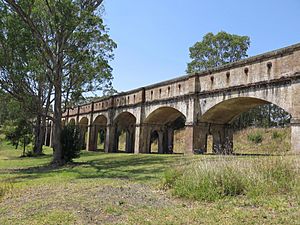Boothtown Aqueduct facts for kids
The Boothtown Aqueduct is an old "water bridge" in Greystanes, Sydney, New South Wales, Australia. It was built in 1888. This special bridge was made to carry water across a valley. It moved water from Prospect Reservoir to people living in Greater Western Sydney.
The aqueduct is part of the Lower Prospect Canal Reserve. It was the longest concrete structure of its kind in Australia for many years. It became a protected heritage site in November 1991. The aqueduct was built as part of a bigger project called the Upper Nepean Scheme. This project brought water from the new Prospect Reservoir to the new Potts Hill Reservoir.
History of the Aqueduct
In 1892, parts of the aqueduct's side walls, called parapets, fell into the creek below. Workers rebuilt these walls and made them stronger. They added a concrete lining and metal tie rods to hold them together.
The aqueduct could not carry enough water as Sydney grew. So, in 1907, a new way to move water was built next to it. This new structure was called an inverted syphon. It used gravity to push water across the valley and up into the canal on the other side. This meant the aqueduct was no longer needed for water.
In the 1990s, there were plans to knock down the aqueduct. But local people protested and saved it! The aqueduct and the land around it became part of the Western Sydney Cycle Network. The Government of New South Wales gave $100,000 to help. A cycleway was built over a few years, starting in 2001 and finishing in 2003.
The old Lower Canal and syphon were replaced again in the 1990s by a new pipeline. The bushland around the canal opened to the public in 2003 as a cycleway. This means you can now walk or ride your bike where water once flowed!
How the Aqueduct Looks
The aqueduct is made of 22 brick arches. Each arch is about 10 meters wide. It was named after John Booth. The aqueduct looks like a cool puzzle. Its size changes, and the arches line up differently depending on where you stand.
Today, the concrete legs look old and weathered. Rain and time have stained them. You might also see some vandalism on the arches.
The towers are made of brick and decorated with cement designs. They have pointed arch doorways. The aqueduct was blocked with concrete to send water into the new pipe. The tower entrances had metal grates and gates to control the water flow. You can see pretty designs in the brickwork, like small tooth-like patterns and flat columns next to each arch. Metal rods help hold the side walls in place.
Visiting the Aqueduct
The Boothtown Aqueduct is on Macquarie Road in Greystanes. It's in an area with lots of trees and parks. Houses built in the 1960s surround it.
You can also get to the aqueduct from Gipps Road on the west side. There are Transit Systems Sydney bus stops nearby on both roads. A path for bikes and walkers goes along the top of the aqueduct. This path crosses Boothtown Gully and goes west towards Prospect Reservoir. These cycleways and walking tracks connect to many other paths across Sydney.
Gallery









